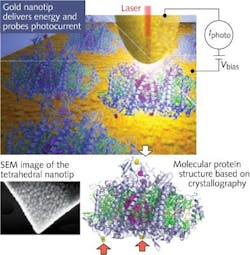Photosynthesis converts plant energy into chemical energy and some proteins can be used to produce a photocurrent, essentially acting as photosynthetic photovoltaic (PV) devices. Researchers at Technische Universität München (Garching, Germany), Ben Gurion University of the Negev (Be’er Sheva, Israel), and Tel Aviv University (Tel Aviv, Israel) have recently tackled the very difficult task of measuring the photocurrent of a single functionalized photosynthetic protein system, demonstrating that such systems could be integrated and selectively addressed in PV device architectures while retaining their biomolecular properties, acting as single-molecule electron pumps for current generation in nanoscale electric circuits.
First, a method was developed to electrically contact single molecules in a strong optical field by covalently binding self-assembled photosynthetic proteins to a gold electrode using cysteine mutation groups (amino acids that assist the binding process). A gold-covered tetrahedral-shaped glass tip both delivers a photon flux and electrically probes the optically excited proteins to measure photocurrent in a scanning near-field optical microscopy (SNOM)-based setup. Photocurrent values for single photosynthetic proteins were measured to be on the order of 10 pA. Contact Joachim Reichert at[email protected].
